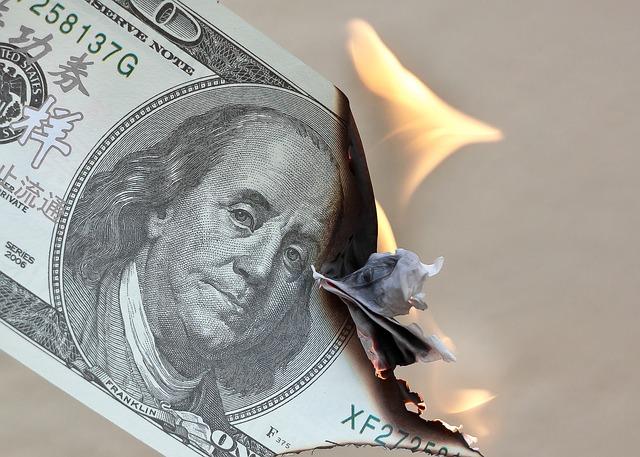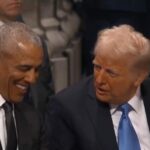We support our Publishers and Content Creators. You can view this story on their website by CLICKING HERE.
“Trump Will Fix It,” the campaign sticker says. If President Trump is serious about fixing things, then he should turn to reforming monetary policy. The U.S. dollar is broken. It is not a stable measure of value, the economy cannot shake a persistent condition of inflation, and a major government debt crisis looms. All of these maladies have their cause in a sick currency. A remedy is available. Our ancestors used it.
In most of the 19th century there were only two kinds of currencies in existence: those that were defined in terms of gold and those that disappeared. There was no middle ground. Most Americans don’t know that their own country went through two episodes of currencies that disappeared without a trace. The Continental dollar was tried during and after the Revolutionary War, but it depreciated badly and disappeared from use, and during the Civil War, the Union issued an emergency currency, called “greenbacks,” and it, too, became worthless and disappeared.
By the end of the 19th century a third kind of currency appeared in history. It is what economists call “fiat money,” which does not have a definition in terms of something of value, such as gold, but is accepted as a medium of exchange. All currencies in the world today are fiat currencies: they change constantly in value against each other but are not fixed to any objective definition of value. The world has been doing business like this since 1971, the year in which the U.S., the sole remaining adherent to a gold-defined currency, severed the dollar’s link to gold.
This period of floating fiats has been marked by endemic currency crises, hyperinflation, stagnation, and sovereign debt problems. Countries with weak currencies try to solve the problem by tying them to the value of stronger ones, typically the U.S. dollar or the euro, but these, too, have no definition of intrinsic value. Thus, in many countries today it is common to find two currencies in circulation alongside each other: a weak local currency and, in many cases, the U.S. dollar.
Of all the fiats, the U.S. dollar has obviously been the most successful. It lubricates international trade and is the default measure of value between markets. It is also seen as a safe haven, something to hold onto in times of political or economic uncertainty. A flight into the dollar may be an option for a middle class family in an emerging market, but where do Americans themselves flee when they lose confidence in the money in their purse?
In place of a “gold standard,” we might say the U.S. dollar today is on a “Ph.D standard.” The Federal Reserve, curator of the dollar’s value, employs more Ph.D economists than any institution in the world. Every six weeks, an inner circle of the Fed’s governors meets to decide where to set short-term interest rates. They presumably make use of the Fed’s prodigious in-house expertise. Setting short-term interest rates is the Fed’s primary tool of monetary policy. The process is subjective and opaque.
During his first administration, Donald Trump inserted himself into that process. His spats with the Fed chairman made headlines and he often grumbled that the Fed wasn’t lowering interest rates fast enough so as to stimulate the economy. The error here is not so much that Trump’s jawboning impinged upon the Fed’s purported independence, but rather that the president presented himself as having better knowledge than the experts on where to set interest rates. Yet if the president and his currency manager disagreed on rates, they both agreed that setting them is a proper function of government. They’re piano tuners disputing the tuning. That’s the problem.
Reinstating gold in monetary affairs would remove the subjectivity, opaqueness, and political pressures in the present system. One technique would be to adopt a “gold price mechanism,” an idea that has been around for decades, and some pundits say that the price of gold almost certainly is taken into account in the Fed’s secret deliberations. The Trumpian reform would make gold-price targeting official policy.
This can be done by setting up a long-term moving average for gold, using a value for each month. Thus, a ten-year moving average would have 120 data points. The time frame could be longer, but whichever one is used, it should be long enough to capture most of the dollar-denominated contracts still in existence.
This set-up would provide the currency manager with three rules for market interventions:
- If the price of an ounce of gold trends above its long-term average price, that would be considered an “inflationary” signal. The Fed’s response would be to drain liquidity from the system. Ordinarily, this means it would sell bonds.
- If the price of gold trends below its long-term average price, that would be considered a “deflationary” signal. The Fed’s response would be to inject liquidity into the system. This would mean it should buy bonds.
- If the price is near its long-term average, do nothing.
That’s it. It’s not perfect because a moving average gives us something other than a fixed value, but it’s good enough and better than what we have now. It’s a turn toward bringing about greater stability in the value of currencies. The consequences of such a change are substantial.
For one thing, reinstating gold’s monetary role would end the era of “floating exchange rates.” If Countries A, B, and C define their national currencies in terms of a long-term average price of gold, then their cross-rates would tend to stabilize because things equal to the same thing are equal to each other. Fixed exchange rates were a feature of the world economy before 1971.
Fair to say that President Trump himself would have an adult memory of that, but his younger advisors have had no such experience. They have grown into adulthood thinking that constantly changing currency rates are a natural feature of economics and that they can be prudently managed by government officials who know what they’re doing.
Note that if a small country adopted a gold-price rule it would not need tons of gold bullion in its vaults. The currency manager could adjust the supply of the national currency by referring to a price signal from gold. Those adjustments would be made by buying or selling bonds or other assets, which of course would include gold bullion.
The restoration of gold would put an end to the Fed’s “Ph.D standard.” Gone would be any discretion given to such things as the “money supply” or the consumer price index or the unemployment rate or, more recently, “climate risk.” The Fed would be obliged only to maintain the dollar’s value in terms of the gold’s long-term price. The Fed could do this by fiddling with short-term interest rates, which is what it does today, but the interest rate tool is crude and inefficient. Gold allows the Fed to get out of the interest rate business. Let the market decide. If the Fed maintains the value of the dollar within the parameters of a gold-price rule, then market forces would determine interest rates up and down the maturity spectrum.
Politicians would have to adjust to the idea that the Fed would no longer have a “discretionary monetary policy,” apart from holding the dollar stable against the price of gold. If politicians are unsatisfied with the economy’s performance, they have at their disposal fiscal and regulatory tools. What they must not do is to try to achieve macro-economic goods by constantly changing the value of the underlying currency. That is the bane of all fiat currencies. It is a destructive delusion.
For the last 53 years the U.S. dollar has been the strongest fiat among fiats. Because of this, America has been spared the financial ravages that have afflicted other countries: chronically high levels of inflation, bouts of hyperinflation, sovereign debt crises, etc. These are things that happen to other people. We read about them in the news. It can’t happen here. And yet in American history two currencies have completely disappeared.
The U.S. dollar is sick and it’s getting sicker every day. The sickness is not just because the Fed makes mistakes. The sickness is in the nature of a fiat currency. It is intrinsic to it. It is not good enough for the Fed to say that it has a two percent inflation target in view and that it’s on track to meet that goal. Inflation always seems to be slow cooking on a gentle flame, but the flame is fire and eventually it will devour everything it touches.
The voters who gave Donald Trump victory get this. Pollsters and pundits alike underestimated the importance they put on price stability: the cost of groceries, health care, rent, you name it. The voters went for Trump because there’s a broad feeling in the land that something is out of control and that something is wrong with the money in their purse.
It will be impossible to make America prosperous again without restoring gold to its monetary role.
James Soriano is a retired Foreign Service Officer. He has previously written on The American Thinker on the war in Ukraine.

Image: Free image, Pixabay license.

 Conservative
Conservative  Search
Search Trending
Trending Current News
Current News 






